Статьи журнала - International Journal of Modern Education and Computer Science
Все статьи: 968
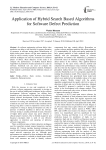
Application of hybrid search based algorithms for software defect prediction
Статья научная
In software engineering software defect class prediction can help to take decision for proper allocation of resources in software testing phase. Identification of highly defect prone classes will get more attention from tester as well as security experts. In recent years various artificial techniques are used by researchers in different phases of SDLC. Main objective of the study is to compare the performances of Hybrid Search Based Algorithms in prediction of defect proneness of a class in software. Statistical test are used to compare the performances of developed prediction models, Validation of the models is performed with the different releases of datasets.
Бесплатно
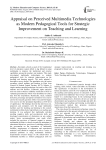
Статья научная
Secondary schools as part of the foundational level of education cannot afford to lag behind in using multimedia to improve the intellectual and creative capabilities among the teachers and students. This study investigated multimedia technologies as modern pedagogical tools for strategic improvement on the teaching and learning process. The study adopted a descriptive survey design. The population was the senior secondary school students and teachers in Kuje Area Council of Federal Capital Territory (FCT), Nigeria. A simple random sampling technique was used to select 250 students and 100 teachers. Cronbach's alpha statistical tool was used to obtain a reliability coefficient of 0.83 on validated questionnaires which were distributed to collect data from the respondents. Statistically, mean, standard deviation, percentage and partial correlation were used to answer the research questions while t-test and Chi-Square were used to test the postulated hypotheses at 0.05 level of significance. The findings showed that television sets, projectors and computers were the major multimedia facilities used for teaching and learning in the council, multimedia facilities had a high influence on teaching and learning. It was gathered that multimedia enriched teaching cognitive skills and psychomotor skills and developed concretization of abstraction on any subject matter. Some recommendations were made which included the provision of financial support to procure multimedia facilities to schools towards the attainment of educational objectives, provision of subsiding policies by the government on the importation of multimedia facilities, employment of competent and experienced technical staff should be employed to solve a series of technical problems in using multimedia facilities. Experimental research design on the effectiveness of multimedia facilities as modern pedagogical tools for strategic improvement on teaching and learning was proposed for future work.
Бесплатно
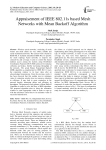
Appraisement of IEEE 802.11s based Mesh Networks with Mean Backoff Algorithm
Статья научная
Wireless mesh networks, consisting of mesh routers and mesh clients are very robust, reliable and easily maintained networks. The current work is based on IEEE 802.11 standard amendment IEEE 802.11s specific for mesh topology based networks to improve the connectivity and coverage. It aims to control the shared medium access among the stations using Distributed Coordination Function (DCF) MAC protocol for reducing collisions and delays, thereby increasing throughput of the network.. The actual Binary Exponential Backoff (BEB) algorithm as implemented in IEEE 802.11 resets the contention window to its least value after an acknowledged transmission. From the previous works it has been observed that this sudden reset to minimum value of contention window does not ensure a reduction in collisions. It may lead to more contention in the network thereby increasing delays and affecting its throughput. The proposed work presents a Mean Backoff Algorithm in order to solve this flaw of BEB algorithm. The proposed algorithm aims to bring the contention window to some appropriate value in order to cope up with the unfairness caused due to its minimum value on successful transmission.
Бесплатно
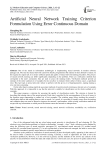
Artificial Neural Network Training Criterion Formulation Using Error Continuous Domain
Статья научная
One of the trends in information technologies is implementing neural networks in modern software packages [1]. The fact that neural networks cannot be directly programmed (but trained) is their distinctive feature. In this regard, the urgent task is to ensure sufficient speed and quality of neural network training procedures. The process of neural network training can differ significantly depending on the problem. There are verification methods that correspond to the task’s constraints; they are used to assess the training results. Verification methods provide an estimate of the entire cardinal set of examples but do not allow to estimate which subset of those causes a significant error. This fact leads to neural networks’ failure to perform with the given set of hyperparameters, making training a new one time-consuming. On the other hand, existing empirical assessment methods of neural networks training use discrete sets of examples. With this approach, it is impossible to say that the network is suitable for classification on the whole cardinal set of examples. This paper proposes a criterion for assessing the quality of classification results. The criterion is formed by describing the training states of the neural network. Each state is specified by the correspondence of the set of errors to the function range representing a cardinal set of test examples. The criterion usage allows tracking the network’s classification defects and marking them as safe or unsafe. As a result, it is possible to formally assess how the training and validation data sets must be altered to improve the network’s performance, while existing verification methods do not provide any information on which part of the dataset causes the network to underperform.
Бесплатно
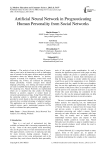
Artificial Neural Network in Prognosticating Human Personality from Social Networks
Статья научная
The analysis of text in the form of tweets, chat or posts can be an interesting as well as challenging area of research. In this paper, such an analysis provides information about the human behavior as positive, negative or neutral. For simplicity, tweets from social networking site, Twitter, are extracted for analyzing human personality. Various concepts from natural language processing, text mining and neural networks are used to establish the final outcome of the application. For analyzing text, Neural Networks are implemented which are so modeled that they predict the Human behavior as positive, negative or neutral based on extracted and preprocessed data. Using Neural Networks, the particular pattern is identified and weights are provided to words based on the extracted pattern.Neural networks have an added advantage of adaptive learning. This application can be immensely useful for politics, medical science, sports, matrimonial purposes etc.The results so obtained are quite promising.
Бесплатно
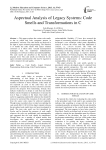
Aspectual Analysis of Legacy Systems: Code Smells and Transformations in C
Статья научная
This paper explores the various code smells or the so called bad code symptoms present in procedural C software. The code smells are analyzed in the light of aspect oriented programming. The intention is to handle the code smells with aspect oriented constructs as it offers more versatile decomposition techniques than the traditional modularization techniques, for software evolution and understandability. The code smells are described at the function and program level. The code smells are followed by the aspect oriented transformations that may be required in order to improve the code quality.
Бесплатно
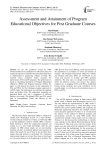
Assessment and attainment of program educational objectives for post graduate courses
Статья научная
As per the guidelines issued by NBA (National Board of Accreditation) of All India Council of Technical Education (AICTE) Outcome Based Education is implemented in engineering colleges of India. The outcome based evaluation model measures the performance of UG and PG programs. The performance is based on calculating attainments of Program Educational Objectives (PEOs) and Program Outcomes (PO).In this paper we will discuss the process for the attainments of POs and PEOs for Post Graduate program approved by AICTE, India. The attainments are calculated by applying direct and indirect tools. The attainments summaries are generated Batch wise and a comparison of different Batches were made. The attained PEOs and POs would help in accomplishing Vision and Mission of the department.
Бесплатно
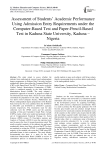
Статья научная
The study aimed to assess whether the students from mathematical science-based undergraduate degree programmes in Kaduna State University perform academically better when either the Computer-Based Test (CBT) or the Paper-Pencil Test (PPT) is used to write the Unified Tertiary Matriculation Examination (UTME), which is conducted annually by the Joint Admissions Matriculation Board (JAMB). The study adopted a quantitative approach to research. A purposive sample of one thousand and twenty-three (1023) first-year students constituted the population for the study. This population was drawn from Computer Science, Mathematics and Physics undergraduate degree programmes in the Kaduna State University who were admitted from the 2010/2011 to 2012/2013 and 2015/2016 to 2016/2017 academic sessions respectively. The instruments used for data collection were the UTME scores and the academic standing of first-year Cumulative Grade Point Average (CGPA) results, which were coded and analysed with the aid of Computational Statistical Package for Social Sciences (SPSS) version 23. Descriptive statistics and Analysis of Variance (ANOVA) were the statistical tools used to answer the four (4) research questions raised. The results revealed a majority of the students who performed academically better were those who used the PPT as their test medium in writing the UTME. It concluded that the majority of the students who wrote the UTME using PPT performed better in their academics. The study thereby recommended that there is a need for the Joint Admissions Matriculation Board (JAMB) to review its examination policies in mathematics-based subjects to enable students to pass such subjects with flying colours, thereby encouraging them to perform better academically in the undergraduate studies.
Бесплатно
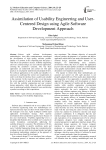
Статья научная
Various agile software development methodologies, since their commencement, encouraged the development of high quality software product. Quality of a product is the compelling trait that plays a vital role in any product's success. Usability engineering and User centered design are user-centered approaches, covering the customer's concerns. The way these approaches are understood and carried out with agile practices is not properly understood and adopted till now. For software applications to be usable and valuable it is necessary to understand the correct user requirements in order to develop the interface that is usable and valuable to the customer. In this research work, we are discussing the scrum approach of agile development and integrate this with the usability engineering and user centered design approaches which helps the agile development team to understand usability demand of users and develop a product according to their expectations.
Бесплатно
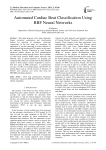
Automated Cardiac Beat Classification Using RBF Neural Networks
Статья научная
This paper proposes a four stage, denoising, feature extraction, optimization and classification method for detection of premature ventricular contractions. In the first stage, we investigate the application of wavelet denoising in noise reduction of multi-channel high resolution ECG signals. In this stage, the Stationary Wavelet Transform is used. Feature extraction module extracts ten ECG morphological features and one timing interval feature. Then a number of radial basis function (RBF) neural networks with different value of spread parameter are designed and compared their ability for classification of three different classes of ECG signals. Genetic Algorithm is used to find best value of RBF parameters. A classification accuracy of 100% for training dataset and 95.66% for testing dataset and an overall accuracy of detection of 95.83% were achieved over seven files from the MIT/BIH arrhythmia database.
Бесплатно
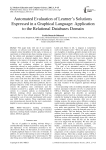
Статья научная
This paper deals with one of our research directions on software tools enhancing self-learning in computer science disciplines. In this study, we discuss an experiment on relational data bases learning using a tool for the edition and automated evaluation of learners’ solutions given as relational algebra trees. Indeed, in addition to the interest of the graphic languages for any training, the evaluation of our precedent works on modeling and evaluating solutions as algebraic expressions showed us some problems: first, there are various languages for the algebraic expressions. Second, among the detected errors by the prototype, developed in our precedent works for algebraic expressions, the form errors about the algebraic language have to be corrected before starting the semantic analysis. Third, in some cases, errors in the form have led to other non-committed errors which can cause inconsistencies in the errors’ diagnosis process. Starting from these problems, the two principal objectives of the work presented in this article concern the algebraic trees construction and the evaluation assisted by a graphic tool which essentially consists in a semantic analysis as recommended in ODALA (ontology driven auto-evaluation learning approach) that we have already proposed. The tool was evaluated by a set of tests and experimented with second year LMD license students. These experiments results were interesting and showed that the tool is particularly helpful for novice students and their teachers.
Бесплатно
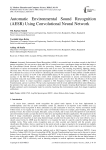
Automatic Environmental Sound Recognition (AESR) Using Convolutional Neural Network
Статья научная
Automatic Environmental Sound Recognition (AESR) is an essential topic in modern research in the field of pattern recognition. We can convert a short audio file of a sound event into a spectrogram image and feed that image to the Convolutional Neural Network (CNN) for processing. Features generated from that image are used for the classification of various environmental sound events such as sea waves, fire cracking, dog barking, lightning, raining, and many more. We have used the log-mel spectrogram auditory feature for training our six-layer stack CNN model. We evaluated the accuracy of our model for classifying the environmental sounds in three publicly available datasets and achieved an accuracy of 92.9% in the urbansound8k dataset, 91.7% accuracy in the ESC-10 dataset, and 65.8% accuracy in the ESC-50 dataset. These results show remarkable improvement in precise environmental sound recognition using only stack CNN compared to multiple previous works, and also show the efficiency of the log-mel spectrogram feature in sound recognition compared to Mel Frequency Cepstral Coefficients (MFCC), Wavelet Transformation, and raw waveform. We have also experimented with the newly published Rectified Adam (RAdam) as the optimizer. Our study also shows a comparative analysis between the Adaptive Learning Rate Optimizer (Adam) and RAdam optimizer used in training the model to correctly classifying the environmental sounds from image recognition architecture.
Бесплатно
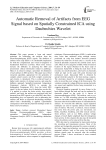
Статья научная
This paper presents a boon and amend technique for eradicating the artifacts from the Electroencephalogram (EEG) signals. The abolition of artifacts from scalp EEGs is of considerable implication for both the computerized and visual investigation of fundamental brainwave activities. These noise sources increase the difficulty in analyzing the EEG and procurement clinical information related to pathology. Hence it is critical to design a procedure for diminution of such artifacts in EEG archives. This paper uses a blind extraction algorithm, appropriate for the generality of complex-valued sources and both complex noncircular and circular, is introduced. This is achieved based on higher order statistics of dormant sources, and using the de?ation approach Spatially-Constrained Independent Component Analysis (SCICA) to separate the Independent Components (ICs) from the initial EEG signal. As the next phase, level-4 daubechies wavelet db-4 is applied to extract the brain activity from purged artifacts, and lastly the artifacts are projected back and detracted from EEG signals to get clean EEG data. Here, thresholding plays an imperative role in delineating the artifacts and hence an improved thresholding technique called Otsu’s thresholding is applied. Experimental consequences show that the proposed technique results in better removal of artifacts.
Бесплатно
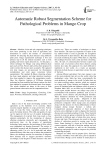
Automatic Robust Segmentation Scheme for Pathological Problems in Mango Crop
Статья научная
Machine vision and soft computing techniques have been promising in the field of agriculture and horticulture to remove the barriers of conventional methods for detecting the plant diseases using different plant parts. Image segmentation technique is first and primary step in all the related researches such as fruit grading, leaf lesion region detection etc. In this paper, a robust technique for Mango crop using different plant parts such as Fruit, Flower and Leaf has been proposed in order to detect the disease more accurately. The captured real time images are pre-processed for illumination normalization and color space conversion before segmentation. The standard K-Means clustering scheme has been made adaptive and edge detection transforms have been applied to improve the segmentation results. Here, the objective function of K-Means clustering technique has been modified and cluster centers also have been updated to segment the diseased parts from images. The results obtained are better in the terms of both general human observation and in computational time.
Бесплатно
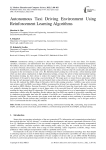
Autonomous Taxi Driving Environment Using Reinforcement Learning Algorithms
Статья научная
Autonomous driving is predicted to alter the transportation industry in the near future. For decades, carmakers, researchers, and administrators have already been working in this sector, with tremendous development. Nevertheless, there are still many uncertainties and obstacles to solve, not only in terms of technical technology, as well as in terms of human consciousness, culture, and present traffic infrastructure. With respect to technological challenges, precise route identification, avoiding the improper location, time delay, erroneous drop-off, unsafe path, and automated navigation in the environment are only a few. RL (Reinforcement Learning) has evolved into a robust learning model which can learn about complications in high dimensional settings, owing to the advent of deep representation learning. Environment learning has been shown to reduce the required time delay, reduce cost of travel, and improve the performance of the agent by discovering a successful drop-off. The major goal is to ensure that an autonomous vehicle driving can reach passengers, pick them up, and transport them to drop-off points as quickly as possible. For performing this task, RL methods like DQNs (Deep Q Networks), Q-LNs (Q-Learning networks) , SARSAs (state action reward state actions), and ConvDQNs (convolution DQNs) are proposed for driving Taxis autonomously. RL agent’s decisions are based on MDPs (Markov Decision Processes). The agent has effectively learnt the closest path, safety, and lower cost, gradually obtaining the capacity to travel bigger areas of the successful drop-off without negative incentive for reaching the target using these RL approaches. This scenario was chosen based on a set of requirements for simulating autonomous vehicles using RL algorithms. Results indicate that ConvDQNs are capable of successfully controlling cars in simulation environments than other RL methods. ConvDQNs are a combinations of CNNs (Convolution Neural Networks) and DQNs. These networks show better results than other methods as their combining of procedures gives improved results. Results indicate that ConvDQNs are capable of successfully controlling a car to navigate around a Taxi-v2 environment than the existing RL methods.
Бесплатно
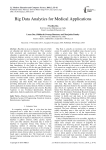
Big data analytics for medical applications
Статья научная
Big Data is an accumulation of data sets which are abundant and intricate in character. They comprise both structured and unstructured data that evolve abundant, so speedy they are not convenient by classical relational database systems or current analytical tools. Big Data Analytics is not linearly able to expand. It is a predefined schema. Now big data is very helpful for backup of data not for everything else. There is always a data introducing. It also helps to solve India’s big problems. It also helps to fill the data gap. Health care is the conservation or advancement of health along the avoidance, interpretation and medical care of disorder, bad health, abuse, and other substantial and spiritual deterioration in mortal. Health care is expressed by health experts in united health experts, specialists, physician associates, mid-wife, nursing, antibiotic, pharmacy, psychology and other health. This paper focuses on providing information in the area of big data analytics and its application in medical domain. Further it includes introduction, Challenging aspects and concerns, Big Data Analytics in use, Technical Specification, Research application, Industry application and Future applications.
Бесплатно
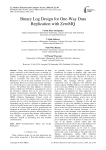
Binary log design for one-way data replication with ZeroMQ
Статья научная
Today, many business transactions are done online, especially in the financial sector or banking [1]. But as companies grow, many problems occur such as the inability to manage data consistency, especially when data is associated with more than one database. Replication is one of the most commonly used way of syncing data. However, to ensure data remains consistent, it is not enough just to take advantage of the replication process. The problem that often happens is connection failure or offline host. The Binary Log approach is one of the alternative methods that can be used to develop database synchronization. Generally, binary log is used for data recovery or backup purposes. Binary log in the DBMS (Database Management System) record all changes that occur in the database both at the data and structure level, as well as the duration of time used. This information can be used as a reference in updating data, while the ZeroMQ socket used as data exchange medium so data in all system locations will be synchronized and integrated in real time. This research will discuss how to develop a synchronization system by utilizing Binary Log from MySQL to recognize data changes, inherit changes, send changes, and hopefully can contribute new alternative method in developing real time database synchronization.
Бесплатно
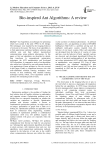
Bio-inspired Ant Algorithms: A review
Статья научная
Ant Algorithms are techniques for optimizing which were coined in the early 1990’s by M. Dorigo. The techniques were inspired by the foraging behavior of real ants in the nature. The focus of ant algorithms is to find approximate optimized problem solutions using artificial ants and their indirect decentralized communications using synthetic pheromones. In this paper, at first ant algorithms are described in details, then transforms to computational optimization techniques: the ACO metaheuristics and developed ACO algorithms. A comparative study of ant algorithms also carried out, followed by past and present trends in AAs applications. Future prospect in AAs also covered in this paper. Finally a comparison between AAs with well-established machine learning techniques were focused, so that combining with machine learning techniques hybrid, robust, novel algorithms could be produces for outstanding result in future.
Бесплатно
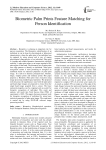
Biometric Palm Prints Feature Matching for Person Identification
Статья научная
Biometrics is playing an important role for person recognition. The Biometrics identification of an individual is can be done by physiological or behavioral characteristics; where the palm print of an individual can be captured by using sensors and is one of among physiological characteristics of an individual. Palm print is a unique and reliable biometric characteristic with high usability. A palm print refers to an image acquired of the palm region of the hand. The biometric use of palm prints uses ridge patterns to identify an individual. Palm print recognition system is most promising to recognize an individual based on statistical properties of palm print image. It is rich in its features: principal lines, wrinkles, ridges, singular points and minutiae points. This paper proposes a Biometric Palm print lines extraction using image processing morphological operation. The proposed work discusses the significance; since both the palm print and hand shape images are proposed to extract from the single hand image acquired from a sensor. The basic statistical properties can be computed and are useful for biometric recognition of individual. This result and analysis will result into Total Success Rate (TSR) of experiment is 100%. This paper discusses proposed work for biometric recognition of individual by using basic statistical properties of palm print image. The experiment is carried out by using MATLAB software image processing toolbox.
Бесплатно
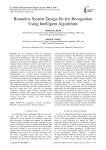
Biometric system design for iris recognition using intelligent algorithms
Статья научная
An iris recognition system for identifying human identity using two feature extraction methods is proposed and implemented. The first approach is the Fourier descriptors, which is based on transforming the uniqueness iris texture to the frequency domain. The new frequency domain features could be represented in iris-signature graph. The low spectrums define the general description of iris pattern while the fine detail of iris is represented as high spectrum coefficients. The principle component analysis is used here to reduce the feature dimensionality as a second feature extraction and comparative method. The biometric system performance is evaluated by comparing the recognition results for fifty persons using the two methods. Three classifiers have been considered to evaluate the system performance for each approach separately. The classification results for Fourier descriptors on three classifiers satisfied 86% 94%, and 96%, versus 80%, 92%, and 94% for principle component analysis when Cosine, Euclidean, and Manhattan classifiers were applied respectively. These results approve that Fourier descriptors method as feature extractor has better accuracy rate than principle component analysis.
Бесплатно

